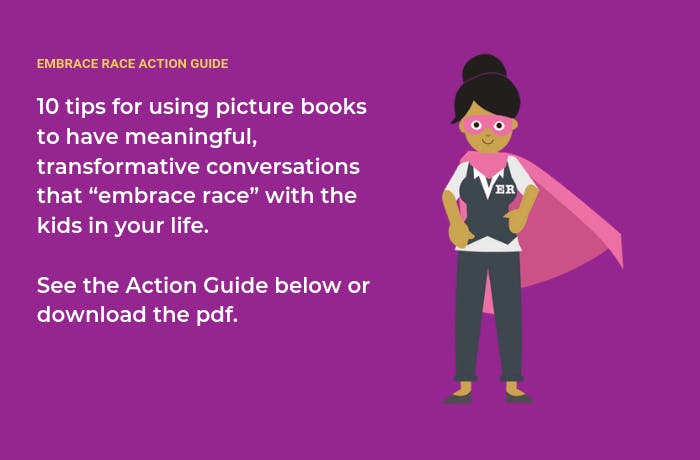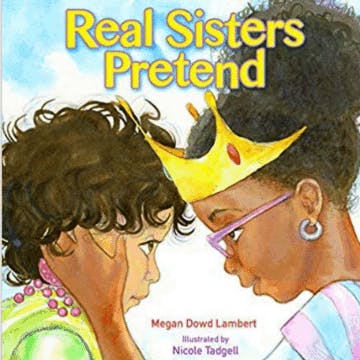10 Tips for Reading Picture Books with Children through a Race-Conscious Lens

How can caregivers and educators best guide children to and through picture books with positive racial representations? How can we also support kids in resisting or reading against racist content? These tips draw on the Whole Book Approach (WBA, which I created in association with The Eric Carle Museum of Picture Book Art) and other resources to highlight how picture books can provoke meaningful, transformative conversations between children and adults that “embrace race.”
1. Draw on expert resources to find and assess diverse books.
In our Talking Race & Kids online conversation, we highlighted We Need Diverse Books but suggested many other great resources, too.
2. Conduct a collection/storytime diversity audit.
How many books by/about People of Color and Native/First Nations people do you count? How many are #OwnVoices titles? What goals can you set?

3. Recognize and leverage the difference between reading to children and reading with children.
Storytimes often use performance methods that position children as an audience with adults reading to them. Shifting to instead read with children through co-constructive models like the WBA can support kids’ critical engagement with picture book representations of race by affirming that their ideas matter.
4. Ask open-ended questions with embedded art and design vocabulary to engage children’s visual literacy.
The WBA uses questions inspired by Visual Thinking Strategies: “What do you see happing in this picture? What do you see that makes you say that? What else can we find?” It also asks questions about art and design, such as why a book uses a portrait or landscape layout, or how endpapers can provide clues about a story. Ensuing discussions expose how creative processes involve choices, which, by extension, can support kids’ understanding that words’ and pictures’ representations of race are ripe for analysis, too.

5. Intentionally integrate discussion about representations of race into shared reading.
Librarian Jessica Anne Bratt offers these tips, adapted from her google doc, “Talking about Race at Storytime”:
- It’s okay to point out racial differences in picture books: “Is that skin color darker or lighter than yours? How would you describe this skin color? Or yours? Or mine?”
- Share your feelings about race and racism when reading together: “It makes me sad that laws allowed certain groups of people like African-Americans to be treated differently.”
- Use “fair/unfair” when talking about racial stereotypes or exclusion in picture books: “Wow, this picture book only includes White male inventors. That’s unfair. Did you know that ____ created things, too? Let’s read about some famous ____ inventors.”
- Embrace cultural and racial differences, and reinforce that “different” and “weird” aren’t the same. “Why is her hair weird?” “Her hair is different from yours. Some people have straight, curly, or wavy hair. It’s great that we’re different.”
- Respect children’s curiosity by responding to their hard questions and sometimes embarrassing observations, or by admitting gaps in your knowledge. “Let me think about that for a while,” or “That’s a good question” or “I don’t know” can be great replies.

6. Use other questions (like these adapted from Lissa Paul) to get kids talking about how words and pictures can reflect, reinforce, or challenge systems of power:
- Whose story is this?
- Who is the reader?
- When and where was the book written? By whom?
- Who is named? And who isn’t?
- Who gets punished? Praised?
- Who speaks? Who is silenced?
- Who acts? Who is acted upon?
- Who looks? Who is observed?

7. Paraphrase and link comments to reinforce ideas and model active listening.
Paraphrasing helps kids feel heard and can let them clarify remarks. Linking ideas fosters collaboration so that many voices make meaning of a text.
8. Welcome diverse responses and interpretations.
In “The Acid Test for Literature Teaching,” reader response theorist Louise Rosenblatt writes, “Books don’t only happen to readers. Readers also happen to books.” It follows that one text can elicit many responses grounded in readers’ particular experiences and perspectives.
9. Stretch beyond your readings/interpretations to center children’s responses.
Scholar, Aidan Chambers, asserts that using open-ended questions and leading with the phrase, “Tell me…” can foster children’s comfort in taking risks in their discussions about books.
10. Be mindful of power dynamics at storytime, starting with the fact that all children exist under adult authority.
How can you empower them? Strive, especially, to hold space for children of marginalized identities addressing exclusion, and for those voicing concern about representation of “mirror” characters.

Megan Dowd Lambert
Get Insights In your Inbox
Join the EmbraceRace community! You will receive the newsletter with our latest on race & kids, including upcoming events and opportunities, resources, community news and curated links.
Subscribe


